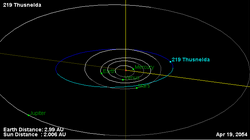Astronomy:219 Thusnelda
From HandWiki
Short description: Main-belt asteroid
 Orbital diagram | |
| Discovery | |
|---|---|
| Discovered by | Johann Palisa |
| Discovery date | 30 September 1880 |
| Designations | |
| (219) Thusnelda | |
| Pronunciation | /ðʌsˈnɛldə/ |
| Named after | Thusnelda |
| A880 SA | |
| Minor planet category | Main belt |
| Orbital characteristics[1] | |
| Epoch 31 July 2016 (JD 2457600.5) | |
| Uncertainty parameter 0 | |
| Observation arc | 117.58 yr (42947 d) |
| |{{{apsis}}}|helion}} | 2.8796 astronomical unit|AU (430.78 Gm) |
| |{{{apsis}}}|helion}} | 1.8302 AU (273.79 Gm) |
| 2.3549 AU (352.29 Gm) | |
| Eccentricity | 0.22281 |
| Orbital period | 3.61 yr (1319.9 d) |
| Average Orbital speed | 19.41 km/s |
| Mean anomaly | 238.118° |
| Mean motion | 0° 16m 21.864s / day |
| Inclination | 10.861° |
| Longitude of ascending node | 200.821° |
| 142.692° | |
| Physical characteristics | |
| Dimensions | 40.56±2.7 km[1] 38.279 km[2] |
| Rotation period | 59.74 h (2.489 d) |
| Geometric albedo | 0.2009±0.030[1] 0.2214 ± 0.0471[2] |
| S[2] (Tholen) | |
| Absolute magnitude (H) | 9.32,[1] 9.34[2] |
Thusnelda (minor planet designation: 219 Thusnelda) is a typical S-type Main belt asteroid. It was discovered by Johann Palisa on September 30, 1880, in Pola and was named after Thusnelda, wife of Germanic warrior Arminius.
In 1982, the asteroid was observed using photometry from the La Silla Observatory to generate a composite light curve. The resulting data showed a rotation period of 1.24 days (29.8 h) with a brightness variation of 0.2 in magnitude.[3]
References
- ↑ 1.0 1.1 1.2 1.3 "219 Thusnelda". JPL Small-Body Database. NASA/Jet Propulsion Laboratory. https://ssd.jpl.nasa.gov/sbdb.cgi?sstr=219;cad=1.
- ↑ 2.0 2.1 2.2 2.3 Pravec, P. et al. (May 2012), "Absolute Magnitudes of Asteroids and a Revision of Asteroid Albedo Estimates from WISE Thermal Observations", Asteroids, Comets, Meteors 2012, Proceedings of the conference held May 16–20, 2012 in Niigata, Japan (1667), Bibcode: 2012LPICo1667.6089P. See Table 4.
- ↑ Lagerkvist, C.-I.; Kamel, L. (December 1982), "Physical studies of asteroids. X - Photoelectric light curves of the asteroids 219 and 512", Moon and the Planets 27: 463–466, doi:10.1007/BF00929999, Bibcode: 1982M&P....27..463L.
External links
- The Asteroid Orbital Elements Database
- Minor Planet Discovery Circumstances
- Asteroid Lightcurve Data File
- 219 Thusnelda at AstDyS-2, Asteroids—Dynamic Site
- 219 Thusnelda at the JPL Small-Body Database
 |

